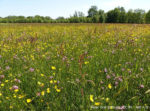by Ilka Dege, DNR
The dominant industrial agriculture in Germany and Europe threatens biodiversity and the climate. By contrast, in particular organic farming ensures a sustainable biomass production.
Foto: © Eva-Maria Lopez
Discussions about the opportunities of the bioeconomy regularly set free a number of promises disguised in sustainability rhetoric. Their obvious weakness is: Where will the required resources come from, or how will they be produced?
The climate policy’s demand to keep fossil raw materials in the ground is an indisputable fact. But can we substitute renewable for fossil resources?
In view of the enormous demand for resources, the substitution is an outrageous claim that agriculture cannot accomplish neither with traditional nor innovative methods that are pushed. Therefore, the only valid sustainable bioeconomy concepts are those based on the need to reduce resource consumption.
The failures in the field of bioenergy clearly show the wrong direction that mere replacement strategies can take. Hyped as a promising field of the bioeconomy only a few years ago, its legacy are deserts of palm oil plantations and corn, including an absurd subsidy policy, causing people and ecosystems around the world to suffer until today.
Today’s bioeconomy strategy lacks convincing answers that go beyond the simple substitution of raw materials – despite increasing resource demands for energy, industry and other uses (1). Within the frame of the planetary boundaries and the already prevailing competition for land, the starting point of all debates and calculative assumptions must be the types of agricultural methods ensuring a supply of biological resources unlimited in time and not in quantity.
Using additional land for agriculture is not an option. In 2019, two shocking reports, the Intergovernmental Panel on Biological Diversity and the Intergovernmental Panel on Climate Change have made clear the extent to which habitats and biodiversity are threatened and, as a result, ecosystem services are declining (2). Once nature ceases to play along, yields will decrease, leading to less instead of more resources.
In turn, this means to keep reserve areas untouched. The management of existing agricultural land must nurture and care for natural resources such as water, soil, air and biodiversity.
Therefore, Germany and Europe should be careful not to propagate and export their dominating type of agriculture as a model for the rest of the world.
The higher yields that have been achieved in recent decades cause an increasing dependence on mineral fertilisers and pesticides that have reached their limits and come at the expense of the environment and nature.
The resulting land degradation is tremendous: loss of humus in the soil, nitrate and pesticide contamination of water bodies and emissions from intensive livestock farming in the air. In addition, food consumption in Europe far exceeds the available land and is dependent on imports from the Global South (3). The type of agriculture we practise in Germany on 90 percent of all agricultural land, as well as our consumption patterns, are therefore part of the problem and not the solution.
This is not a rejection of intensification and innovation. Agro-ecological methods, above all organic farming, and an improved circular economy are the untapped potential to use resources far better than before.
Yet again, biomass ultimately belongs back into the cycle, because nature knows no waste materials. Earthworms, microorganisms and even pollinators depend on it for food and for their continued existence. They thank us with free services and secure yields. If we take the bioeconomy at its word, “organic farming” is the formula for success that underlies the concept.
References:
(1) Umweltbundesamt (2019): Bioökonomiekonzepte und Diskursanalyse
(2) IPBES (2019): Global Assessment Report on Biodiversity and Ecosystem Services
(3) IPCC (2019): Special report on land use and land use change
Ilka Dege is a trained and studied farmer and was coordinator for biodiversity policy at the Deutscher Naturschutzring.







